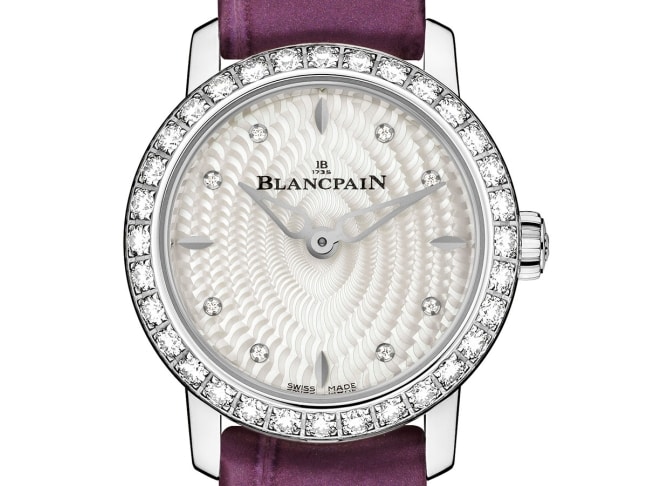1956:一个传奇的诞生
A blend of boldness and ingenuity.
The trade advertising of the time was a challenge to distributors: ″Be the first importer on your market of the world’s smallest roundwatch!″. The Ladybird was born in 1956 when the fashion was for jeweled watches in which the emphasis was on ornamental features and dainty dial sizes. Within this context, Blancpain’s unveiling the world’s smallest round movement, the R550 caliber, was a true masterstroke. Notwithstanding its 11.85 mm diameter, this movement had a more than 40-hour power reserve that was quite extraordinary for the period. For aesthetic reasons, its crown was re-located to the back of the watch. As for the pivot placed above the escape wheel, it was slightly thinner than an average strand of hair, at just 0.07 mm.
Success was instantaneous and it became the timepiece of choice to adorn the wrists of elegant women. As time went by, it adopted a variety of styles intended to meet the most demanding feminine tastes, ranging from entirely gem-set models to more avant-garde versions with interchangeable straps. Year after year, the Ladybird successively appeared in new guises while retaining its ever youthful charm.
Success was instantaneous and it became the timepiece of choice to adorn the wrists of elegant women. As time went by, it adopted a variety of styles intended to meet the most demanding feminine tastes, ranging from entirely gem-set models to more avant-garde versions with interchangeable straps. Year after year, the Ladybird successively appeared in new guises while retaining its ever youthful charm.
From yesterday to today
Sixty years on, its style remains in vogue and Blancpain pays homage to the Ladybird that has played such an important role in the history of women’s timepieces. The new automatic 6150 caliber is just 15.7 mm in diameter and remains one of the smallest in the world.
What could be more logical than to launch this anthem to femininity for Valentine’s Day? On this occasion, a removable charm featuring a ruby heart with a diamond arrow adorns a 99-piece limited edition, while a second 60-piece limited edition is introduced at Baselworld to mark the model’s 60th birthday. The latter features a different design distinguished by luminous contrasts revealing a delicate foliage motif.
The strap has been fashioned in Louisiana alligator leather with especially fine scales in order to create a supremely refined effect. Its bezel has been set with 32 diamonds surrounding eight of the same gems sparkling on the dial, swept over by droplet-shaped hands and framed by a white gold case. The transparent caseback allows a view of the winding rotor, delicately decorated with a diamond. In addition to these new timepieces, the Ladybird collection has been expanded with two other new models presented exclusively at Baselworld. The first features a mother-of-pearl dial bearing 4 small ruby hearts. A removable charm in the form of a reversed heart brings a flirty touch to the model. The second new piece is crafted in red gold. Its opaline dial is surrounded in brilliance thanks to its diamond-set bezel.
This model is enhanced with a ladybird charm set with 7 rubies and 11 diamonds. Consistently and resolutely in tune with the times, the Ladybird has flitted its way to a unique place in the world of women’s watches that it shows no sign of relinquishing.
Betty Fiechter, A pioneering woman leader
Frédéric-Emile Blancpain, a descendant of Jules-Emile, lead the family business from 1889 until 1932. During his years heading Blancpain, he worked alongside a talented young woman, Betty Fiechter, who began her work there at the age of 16 and completed her training with him. Her natural boldness, devotion and intelligence became valuable assets to the business. Frédéric-Emile selected her to manage production and sales. She brought to Blancpain a modern and perceptive outlook that proved its worth to Blancpain and which would lead her to become a major force in its history several years later. When Frédéric-Emile passed away, Betty Fiechter, together with her colleague André Leal, invested her savings to acquire the business under the name "Rayville S.A., successeur de Blancpain". So it was, according to our research, she became, on July 7 1933 the first woman co-owner of a prestigious watch firm. After André Leal died in 1939, she assumed the helm alone, devoting herself single-mindedly to growing the business and notably bringing on board her nephew, Jean-Jacques Fiechter, who demonstrated enormous creativity in modernizing the business. Beginning in 1952, Betty and Jean- Jacques Fiechter developed a range of calibers for jewelry models which opened new avenues and possibilities for jeweled watches and established Blancpain’s international reputation in that domain. Betty Fiechter was a pioneering woman who laid a set of firm foundations for the House of Blancpain.
01
4




